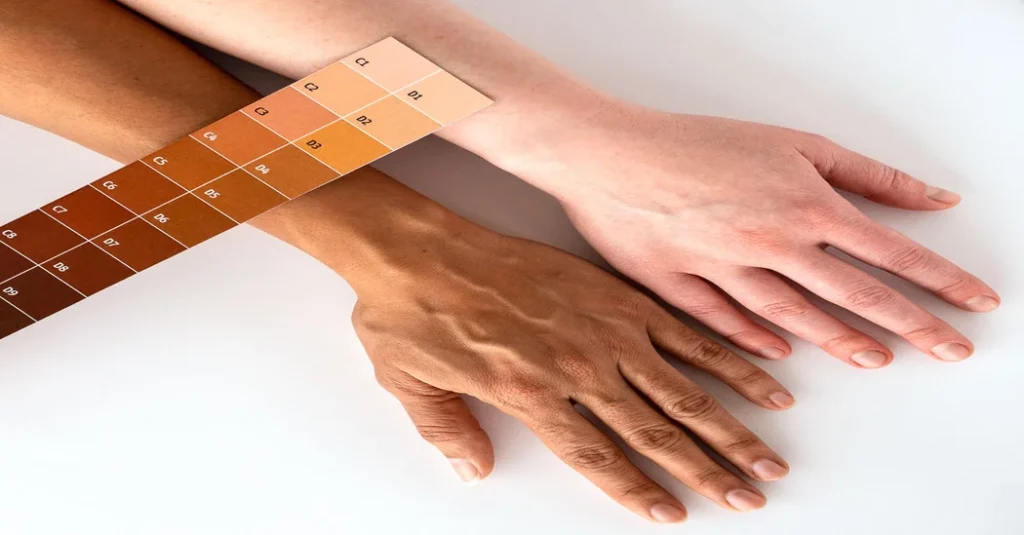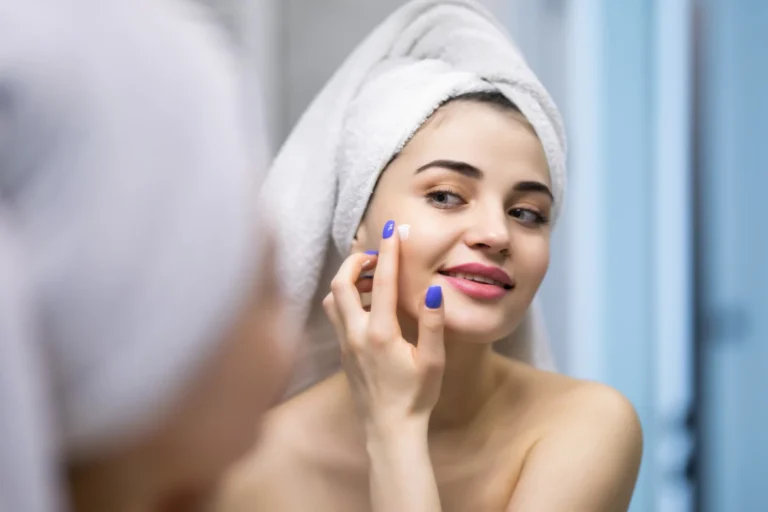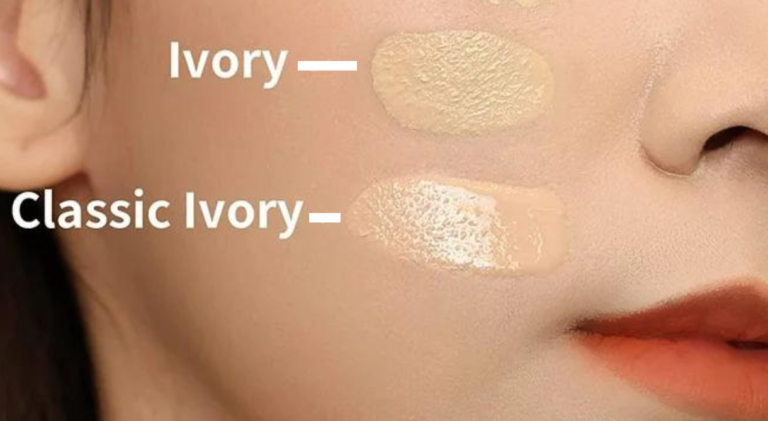Shades of Diversity: Embracing Unique Names for Skin Colors
Introduction
Similar to a painter’s palette of rich hues, skin colors cover a wide range that goes beyond simple description; they convey tales of culture, environment, and distinct uniqueness. The labels we give to skin colors represent a wide range of colors and undertones present in the human experience, from the ethereal fairness of ivory to the rich, dark brown of ebony. Every name represents not just a hue but also a voyage, a lineage, and a vivid aspect of the diversity of humanity. Accepting the wide range of names for skin colors is a celebration of the beautiful mosaic of human physical variation, emphasizing the beauty in the diverse pigmentation that covers each of us.
Understanding Skin Color and Names for Skin Colors
Delving into the fascinating world of skin color reveals a complex tapestry with a beautiful variety of colors, each telling a unique tale. It’s an investigation that goes beyond pigmentation, exploring the cultural importance and linguistic complexity encompassed inside skin color labels rather than just the hues themselves.
Skin color isn’t just a visual attribute; it’s a reflection of genetics, geographical heritage, and societal perceptions. It encompasses a spectrum of names, from the familiar ‘fair’ and ‘dark’ to the evocative ‘caramel’ and ‘Mahogany.’ These names paint vivid pictures, evoking emotions and embodying a diverse cultural tapestry that celebrates human diversity.
This study shows the complex histories and meanings that are ingrained in skin color labels, which in turn reflect the social mores and beauty standards associated with various shades. This fascinating voyage delves into the subtleties and intricacies of human pigmentation, providing a profound understanding of cultural identities and beauty standards.
Melanin’s Function

Melanin, a fascinating pigment found in human skin, is important for reasons other than its look. It works as nature’s shield, protecting our skin from the sun’s harmful UV rays and determining the color of our skin. This pigment isn’t just for looks; it’s a biological miracle that protects us from solar damage while also influencing the various colors that cover our skin.
Beyond its protective role, melanin is an intriguing biological messenger, transmitting information within our bodies that affects our skin health and overall well-being. Its synthesis is a miracle of our genetic composition, comprising a complicated interplay of many genes and cellular systems.
Understanding melanin’s involvement reveals new insights into skincare and sun protection. Adopting appropriate sun care measures, such as using sunscreen on a regular basis and seeking shade during high sun hours, has become crucial beauty advice for protecting our skin’s health and shine while respecting its intrinsic diversity.
Skin Color Genetics

Our skin color isn’t just a surface characteristic; it’s a complicated tapestry created by the intricate interaction of genetics. A mosaic of genes contributes to the generation and dispersion of melanin, the pigment responsible for our skin’s hues, in the genetic inheritance determining skin color.
This genetic mosaic isn’t limited to a single gene but rather includes a slew of them, reflecting the tremendous diversity seen throughout populations. Ancestral ancestry, regional origins, and evolutionary adaptations all leave marks on our genetic makeup, contributing to the astonishing variety of skin colors we see.
Understanding the genetics of skin color not only helps us understand the complexities of our biological ancestry, but it also helps us embrace effective beauty recommendations tailored to our specific skin colors. It enables us to enjoy and care for our skin in a way that honors its unique genetic makeup while underscoring the significance of inclusive beauty standards that promote variety.
Names for Skin Color Examples
Ivory: Ivory skin tone is usually a little darker than a porcelain skin tone. People with this type of skin tone could have a golden, peach, pinkish, or even a bluish undertone. Nicole Kidman and Isla Fisher are two famous actresses who are considered to have ivory skin.
Beige: A beige skin tone is described in different ways—light brown with a gray or yellow tint, gray-yellow, tan with a green undertone, and so on. In most cases, this skin tone falls more on the olive skin tone spectrum. Both Kate Hudson and Sofia Vergara have a beige skin complexion with a slight yellow undertone.
Fair: Fair skin tones often present a light complexion with a subtle pink or rosy undertone. Individuals with fair skin may have a higher sensitivity to the sun and are prone to sunburn due to lower melanin levels.
Light: Pale to slightly brown are examples of light skin tones. These people may have an undertone of neutrality or modest warmth, and their responses to sun exposure may differ.
Medium: Colors ranging from beige to olive complement medium skin tones. They may tan readily and have a modest level of sun sensitivity. They frequently have a warm or neutral undertone.
Olive: Olive skin tones have undertones of green or yellow and a warm, golden color. Olive-skinned people frequently tan easily and possess some inherent protection against sunburn.
Brown: Skin tones with brown undertones range from caramel to chocolate. These tones frequently feature built-in sunburn defense and may have a variety of undertones.
Dark: Dark skin tones have deeper, more melanin-rich hues that naturally shield the skin from UV rays. They are less likely to get sunburned and may have undertones of warmth or coolness.
Ebony: With a high melanin level, ebony skin tones are the richest and deepest colors. They frequently have undertones of warmth and offer strong natural sunburn protection.
Almond: Almond skin tone is a light brown color. People with this type of skin tone have a brown or yellow undertone. Priyanka Chopra and Jessica Alba are two famous actresses who are considered to have almond skin.
Caramel: Caramel skin tone is a warm, golden-brown color. People with this type of skin tone have a yellow or golden undertone. Halle Berry and Tyra Banks are two famous celebrities who are considered to have caramel skin.
Chestnut: The color of chestnut shells is reflected in the deep, rich hues of chestnut skin tones. They often offer some protection against sunburn and can have undertones of warmth or coolness.
Honey: Honey skin tones showcase warm, golden hues similar to the color of honey. Individuals with honey-toned skin might tan easily, but they should exercise caution against excessive sun exposure. Beyoncé and Jennifer Lopez are two famous celebrities who are considered to have honey skin.
Mahogany: This skin tone has rich, reddish-brown tones that are similar to those of mahogany wood. They may naturally shield themselves from UV light and have undertones of warmth. Lupita Nyong’o and Viola Davis are two famous actresses who are considered to have mahogany skin.
Mocha: The color of mocha coffee is reflected in rich, chocolatey skin tones. They may be rather sensitive to the sun and have a range of undertones.
Sienna: The earth pigment sienna is reflected in the warm, reddish-brown hues of Sienna skin tones. They could be easily sunburned and have undertones of warmth or neutrality.
Umber: Deep, earthy tones resembling the hue of natural umber pigment characterize umber skin tones. They may be less susceptible to sunburn and have undertones of warmth frequently.
Alabaster: A person with alabaster skin is viewed as someone with blemish-free, even-toned, and bright-white skin. The Fanning sisters are two celebrities who are considered to have alabaster skin. The Fanning sisters are two famous actresses who are considered to have alabaster skin.
Carotenoid: Carotenoid skin tone is a yellow-orange color. People with this type of skin tone have a yellow or orange undertone. Emma Stone and Julianne Moore are two famous actresses who are considered to have carotenoid skin.
Tan: Tan skin tone is a light brown color. People with this type of skin tone have a brown or yellow undertone. Jennifer Lopez and Eva Mendes are two famous celebrities who are considered to have tan skin.
Bronze: Bronze skin tone is a rich, warm brown color. People with this type of skin tone have a brown or yellow undertone. Rihanna and Iman are two famous celebrities who are considered to have bronze skin.
Buff: Buff skin tone is a pale yellow color. People with this type of skin tone have a yellow undertone. Gigi Hadid and Blake Lively are two famous celebrities who are considered to have buff skin.
Peaches and Cream: Peaches and cream skin tone is a warm, pinkish color. People with this type of skin tone have a pink or peach undertone. Scarlett Johansson and Emma Watson are two famous actresses who are considered to have peaches and cream skin.
Praline: Praline skin tone is a warm, reddish-brown color. People with this type of skin tone have a brown or red undertone. Rihanna and Beyoncé are two famous celebrities who are considered to have praline skin.
Espresso: Espresso skin tone is a dark, rich brown color. People with this type of skin tone have a brown or red undertone. Lupita Nyong’o and Naomi Campbell are two famous models who are considered to have espresso skin.
Porcelain: Porcelain skin tone is a very light, almost translucent color. People with this type of skin tone have a pink or peach undertone. Emma Stone and Taylor Swift are two famous celebrities who are considered to have porcelain skin.
Hickory: Hickory skin tone is a warm, reddish-brown color. People with this type of skin tone have a brown or red undertone. Gabrielle Union and Kelly Rowland are two famous celebrities who are considered to have hickory skin.
Mustard: Mustard skin tone is a warm, golden-yellow color. People with this type of skin tone have a yellow or golden undertone. Jourdan Dunn and Winnie Harlow are two famous models who are considered to have mustard skin.
Sable: Sable skin tone is a dark, rich brown color. People with this type of skin tone have a brown or red undertone. Alek Wek and Iman are two famous models who are considered to have sable skin.
Bisque: Bisque skin tone is a light, pinkish-beige color. People with this type of skin tone have a pink or peach undertone. Gwyneth Paltrow and Cate Blanchett are two famous actresses who are considered to have bisque skin.
Teak: Teak skin tone is a warm, reddish-brown color. People with this type of skin tone have a brown or red undertone. Tyra Banks and Halle Berry are two famous celebrities who are considered to have teak skin.
Cacao: Cacao skin tone is a dark, rich brown color. People with this type of skin tone have a brown or red undertone. Alek Wek and Lupita Nyong’o are two famous models who are considered to have cacao skin.
Pecan: Pecan skin tone is a warm, reddish-brown color. People with this type of skin tone have a brown or red undertone. Viola Davis and Kerry Washington are two famous actresses who are considered to have pecan skin.
Different Categories of Skin Color
A vast spectrum of tones with varying pigmentation, melanin levels, and reactions to sun exposure are included in the many skin color groups. These divisions aid in the categorization and comprehension of the range of human skin tones. They usually consist of fair, light, medium, and dark classifications along with their corresponding subcategories.
These divisions are essential for medical evaluations, skincare, and choosing the right SPF protection depending on skin sensitivity. They aid in recognizing the differences in skin tones and serve as a basis for customized skincare advice.
Fitzpatrick Skin Type Scale
Thomas Fitzpatrick, a physician, created the well-known Fitzpatrick Skin Type Scale, which divides human skin tones into groups according to how they react to UV rays and how easily they get sunburned. The scale, which goes from Type I to Type VI, takes into account things like skin tone, capacity to tan, and sensitivity to sunlight.
Here’s the Fitzpatrick Skin Type Scale Chart:
| Skin Type | Characteristics | Reaction to Sun Exposure |
| I | Very fair skin, always burns, never tans | Severe sunburn risk |
| II | Fair skin, burns easily, tans minimally | High sunburn risk |
| III | Light to medium skin, burns moderately, tans gradually | Moderate sunburn risk |
| IV | Olive or moderate brown skin, burns minimally, tans well | Low sunburn risk |
| V | Dark brown skin, rarely burns, tans easily | Very low sunburn risk |
| VI | Deeply pigmented dark skin, never burns | Minimal sunburn risk |
This scale assists dermatologists, skincare professionals, and individuals in understanding their skin’s reaction to sun exposure and determining appropriate sun protection measures. It aids in assessing skin cancer risks, guiding skincare routines, and selecting suitable skincare products based on individual skin types.
The Fitzpatrick Skin Type Scale chart serves as a valuable tool in understanding and classifying different skin types, helping individuals make informed decisions regarding sun protection and skincare practices tailored to their specific skin tones and sun sensitivity levels.
Von Luschan’s Chromatic Scale
Early in the 20th century, Austrian anthropologist Felix von Luschan’s created Von Luschan’s Chromatic Scale, which used a set of 36 colored glass tiles to classify the colors of human skin. Every tile depicted a distinct tint that could be matched to a person’s skin tone. Based on the closest matching tile, the scale assigned a numerical value to the skin tone, resulting in a scale that ranges from very light to very dark.
In physical anthropology and ethnology, Von Luschan’s Chromatic Scale was a groundbreaking technique for categorizing human skin tones. However, because color matching is subjective and depends on the examiner’s visual judgment, it has limits.
Here’s a representation of Von Luschan’s Chromatic Scale:
| Von Luschan’s Scale | Description |
| 1-5 | Very light skin colors |
| 6-10 | Light skin colors |
| 11-15 | Medium-light skin colors |
| 16-20 | Medium skin colors |
| 21-25 | Medium-dark skin colors |
| 26-30 | Dark skin colors |
| 31-36 | Very dark skin colors |
Due to its subjective nature, this scale’s ability to accurately classify skin colors for anthropological and ethnographic investigations was limited. The Von Luschan’s Chromatic Scale has been replaced by more accurate and trustworthy techniques of classifying skin color as a result of technological breakthroughs that have made it possible to measure skin color objectively through the use of spectrophotometry and digital photography.
While Von Luschan’s Chromatic Scale was useful in the early days of anthropological research, more precise and objective methods for assessing and classifying human skin colors are now available thanks to modern methodologies. This means that anthropological research on human diversity and skin conditions, as well as scientific studies, can now be conducted with greater precision.
Brightening Light Skin Tone
Light skin tones range from the palest tints to those softly caressed by the sun’s warmth, forming a spectrum of subtle hues. Light-skinned people display a variety of complexions that have an airy radiance. These hues often represent a range from porcelain white to softly sun-kissed, providing a diverse canvas within a mild range of pigmentation.
Here’s a breakdown to illustrate the range of light skin tones:
| Skin Tone | Characteristics |
| Fair | Delicate, pale complexion |
| Ivory | Creamy, translucent appearance |
| Peach | Soft, warm undertones |
| Rosy | Subtle pink hues |
| Beige | Light tan shades |
This chart illustrates the complex range of tones that collectively fall under the broad category of light skin tones, illustrating the rich and complex range that exists within this category. These explanations seek to honor the variety and complexity that come with light skin tones, emphasizing the uniqueness and beauty that this spectrum of pigmentation has to offer.
Different Middle Skin Tone
The intriguing range of colors embodied by medium skin tones creates a tapestry of hues that spans the spectrum from lighter to deeper shades. People with medium skin tones have a range of complexions, from warm beige to olive, which reflects a varied combination of pigmentation. These tones frequently have adaptable undertones, which add to a rich and diverse appearance.
Here’s an illustrative breakdown showcasing the diversity within medium skin tones:
| Skin Tone | Characteristics |
| Chestnut | Dark brown skin with cool undertones |
| Olive | Green or yellow undertones |
| Tan | Sun-kissed golden hues |
| Caramel | Rich, golden-brown shades |
| Bronze | Shimmering, deeper tones |
The aforementioned chart aims to demonstrate the diverse range of medium skin tones, recognizing the intricacy and depth inherent in this classification. These descriptions highlight the distinctive and different pigmentations that individuals include within this vast spectrum, with the goal of celebrating the diversity and versatility of medium skin tones.
Beautiful Dark Skin Tone Shade
Dark skin tones boast a captivating array of rich and profound pigmentation, showcasing a diverse spectrum of hues that embody depth and sophistication. Individuals with dark skin tones display a mesmerizing array of complexions, ranging from the warm, reddish-brown tones of mahogany to the deep, earthy shades of umber and sable.
Here’s an expanded representation to illustrate the diverse spectrum within dark skin tones:
| Skin Tone | Characteristics |
| Mahogany | Reddish-brown richness |
| Umber | Deep earthy hues |
| Sable | Dark, lustrous tones |
| Espresso | Intense, velvety shades |
| Cocoa | Rich, chocolatey depths |
| Ebony | Luxurious, deep black hues |
| Onyx | Intensely dark shades |
This chart celebrates the depth and beauty that are inherent in each unique shade of dark skin tone by illustrating the diverse richness and diversity that can be found within them. The aforementioned depictions accentuate the attraction and intricacy encapsulated by the intriguing spectrum of pigmentation found in darker skin tones.
A Broad Spectrum of Variations in Skin Tone
Skin tone variations span a broad spectrum of colorful hues, each of which conveys a distinct tale of beauty and originality. These variances are present in every skin tone group, exhibiting a rainbow of hues impacted by hereditary, geographic, and environmental exposures.
Here’s an illustrative representation showcasing the diverse spectrum of skin tone variations:
| Skin Tone Variation | Characteristics |
| Rosy undertones | Soft pinkish hues |
| Golden undertones | Warm, sun-kissed glows |
| Olive undertones | Greenish or yellowish tones |
| Neutral undertones | Balanced and versatile shades |
| Cool undertones | Bluish or pinkish undertones |
This chart serves to highlight the nuanced variations present within skin tones, emphasizing the complexity and diversity found in each individual’s pigmentation. These descriptions aim to celebrate the intricate variations within skin tones, acknowledging the beauty and uniqueness inherent in the multitude of hues and undertones observed across diverse populations.
Essential Tips for Summer, Winter, and Seasonal Changes
| Summer Season | Winter Season | Seasonal Changes |
| 1. Sun Protection: Shield your skin from UV rays using sunscreen, hats, and sunglasses. | 1. Moisturization: Combat dry skin with hydrating lotions and creams to prevent moisture loss. | 1. Skincare Transition: Adapt skincare routines to address varying humidity levels and temperature changes. |
| 2. Hydration: Stay well-hydrated by drinking plenty of water throughout the day. | 2. Layer Clothing: Dress in layers with insulating fabrics to trap body heat. | 2. Product Adaptation: Adjust skincare products for changing skin needs, like heavier moisturizers in colder months. |
| 3. Appropriate Clothing: Wear lightweight, breathable fabrics and loose-fitting clothes. | 3. Protective Accessories: Use gloves, scarves, and hats to shield against the cold. | 3. Humidity Control: Use humidifiers or adapt skincare for dry indoor conditions during winter. |
| 4. Cooling Strategies: Seek shade and stay indoors during peak sun hours. | 4. Lip and Skin Care Routine: Use lip balm and moisturizers to combat dryness. | 4. Consistent Care: Maintain a consistent skincare routine despite changing weather conditions. |
| 5. Skincare Routine: Use oil-free products and gentle cleansers to prevent breakouts. | 5. Stay Active: Engage in indoor activities or winter sports to maintain circulation. | 5. Professional Advice: Seek dermatologist or skincare professional guidance for seasonal skincare adjustments. |
| 6. Healthy Diet: Consume hydrating foods like fruits and vegetables. | 6. Hydration: Keep drinking water to prevent dehydration caused by indoor heating. | 6. Holistic Approach: Embrace a holistic skincare approach that includes diet, hydration, and suitable products. |
These ideas aim to help you adjust to the difficulties presented by summer and winter, including seasonal changes, so that you have the tools necessary to preserve your skin’s health and general wellbeing all year.
Importance of Skin Tone Knowledge
In Fashion: Understanding one’s skin tone is essential when it comes to fashion since it allows people to choose hues and types of apparel that best suit their skin tone. Knowing one’s skin tone helps one choose colors that accentuate their natural attractiveness and help them put together ensembles that are well-coordinated and fashionable.
In Beauty: Understanding skin tones is essential to beauty since it affects the cosmetic selections made. Understanding your skin undertone helps you choose lipstick, blush, and foundation tones that complement your skin tone, highlighting your best features and giving your face a more put-together yet natural appearance. With this awareness, people can accept cosmetics that highlight their own beauty.
In Cosmetics: In the cosmetics sector, understanding skin tones is crucial. It directs the development of cosmetics that are formulated and made to fit a range of skin tones. In order to create foundations, concealers, and other cosmetics that suit a broad range of skin tones, brands that value inclusivity take into account different undertones. This promotes inclusivity and accessibility in beauty goods.
In Health: Understanding skin tone is crucial in health, especially in dermatology and sun protection. It aids in identifying skin cancer risks, understanding the effects of sun exposure, and guiding skincare routines. Knowledge about one’s skin tone helps in choosing appropriate sunscreens, preventing sunburn and premature aging, and reducing the risk of skin conditions related to UV exposure.
Overall, skin tone knowledge holds immense significance in multiple aspects of life, influencing personal style, beauty choices, cosmetic developments, and health practices, ultimately fostering inclusivity, individual empowerment, and informed decision-making.
Conclusion:
The importance of understanding skin tones extends far beyond the areas of fashion, beauty, and health. It represents a heightened awareness of diversity and individuality in our culture. We build an environment of inclusivity and empowerment by recognizing and appreciating the diverse range of skin tones.
This understanding not only influences personal fashion and cosmetics decisions, but it also acts as a foundation for self-acceptance and confidence. It highlights the significance of recognizing and celebrating each individual’s unique attractiveness, regardless of skin tone.
Furthermore, skin tone awareness is an important component in promoting health-conscious practices, notably in sun protection and skincare. It promotes making informed choices that prioritize skin health and general well-being.
We contribute to a more inclusive and helpful world by recognizing and understanding the value of skin tone variety. It’s a celebration of individual diversity, establishing a society that recognizes and values the unique beauty that each person possesses.







